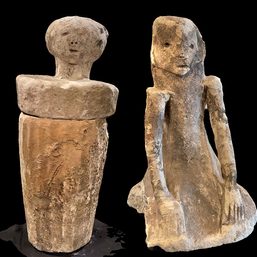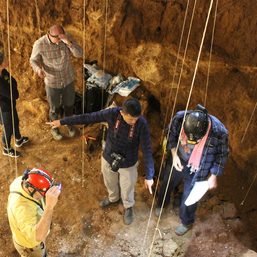SUMMARY
This is AI generated summarization, which may have errors. For context, always refer to the full article.

A team of international scientists were able to directly date a cave painting of a human-like figure in Peñablanca, Cagayan, a recent study showed.
The caves in Peñablanca are a hot spot for recent archaeological findings. In the same region, scientists were able to find a new human species, the Homo luzonensis, and three new species of cloud rats.
The research, published in the international peer-reviewed journal Radiocarbon in April 2021, showed that the rock art of a human-like form with arms up and legs spread open is about 3,500 years old, the oldest of the directly dated rock arts in Southeast Asia.
“We sampled some pigment from the torso of the figure and we dated it to be around 3,500 years ago. Now this date is much older than we previously thought. That’s what makes this finding so exciting because it forces us to reconsider our preconceived notions about similar rock art found across Southeast Asia,” said Andrea Jalandoni of Griffith University, Australia, in a virtual press conference.
Jalandoni is the first author of the paper, citing that similar rock arts found in the Southeast Asian region are more recent at around a thousand years old.
In this particular study, what Jalandoni and her team performed was a method called direct dating. This process is where the paint material from the artwork – in this case, carbon black – was dated using radiocarbon (14C), rather than dating the materials around or on top of the artwork.
“I guess one way to look at it is when you do indirect dating, you get a minimum age, and when you do direct dating, you get a maximum age of the rock art,” said Jalandoni.
Scientists were able to find the black pigment human figure with two other human figures, a few leaf and circle motifs. Similar motifs have been found in various places in Southeast Asia.
“We have previously assumed that black rock art is more recent because black art is placed over red art, or because the subjects depicted are quite modern. This new finding forces us to be more cautious about attributing black rock art as ‘recent,’ and also encourages us to embark on direct dating for more rock art sites in the region,” Noel Hidalgo Tan, a senior specialist in archaeology at the Southeast Asian Regional Centre for Archaeology and Fine Arts in Thailand said in a press release.
The date also supports what scientists have found on other early human occupation activities in the area. Our ancestors were foraging in Eme and Arku caves, and doing pottery in Callao Cave, all within the same limestone formation in Peñablanca.
Jalandoni added that the findings are intriguing as they couldn’t identify which group painted the rock art. Further studies need to be done to do so.
“At 3,500 years ago, this was way before the Spaniards arrived in the Philippines. So, there are two possible artist groups. The Agta or the Negrito group in the region, and Austronesians,” said Jalandoni.
Austronesians arrived in the northern Philippines around 4,000 years ago. The Agta or Negritos, on the other hand, traveled via land bridges much earlier before the end of the Pleistocene, a geological period of up to 10,000 years ago.
“What makes rock art so special is that it allows us to connect with history. When you see a new film, sometimes you want to visit the places that were featured in the film because that makes us part of the story. Similarly, when you’re standing in front of a rock art, you feel connected to the artist because you could be standing right where they were standing when they made the art. You could be smelling the same air and hearing the same cave echoes,” she said.
“The research also shows the significance of these rock art sites and why a conservation plan is desperately needed,” Jalandoni had said in an earlier Griffith University report.
In the report, she had noted that the rock art sites are fast disappearing. “Our team was only able to find 94 out of 250 of the figures traced back in 1976-1977. One rock art site at Hunong Spring has been lost completely and it is concerning as a researcher,” she said.
One of the steps the National Museum of the Philippines and other stakeholders are taking to protect and conserve these archaeological sites is publicizing the study.
“The raising of awareness is a very important measure in archaeological and cultural heritage protection and preservation,” Mylene Lising, National Museum of the Philippines cultural deputy for Cagayan Valley, said during the press conference.
“On the part of the local government, the provincial government of Cagayan is working hand in hand, stronger than ever with the National Museum in raising awareness about the archaeology in Cagayan province. And that is a very important layer of protection…. A lot of the time, destruction happens when people are ignorant of these important archaeological resources in and around the places they live in,” she also said. – Rappler.com
Add a comment
How does this make you feel?
![[The Slingshot] No, no, no, National Museum! The Boljoon artifacts do not belong to you!](https://www.rappler.com/tachyon/2024/02/tl-boljoon-artifacts-nat-museum-02242024.jpg?resize=257%2C257&crop=270px%2C0px%2C720px%2C720px)
![[Time Trowel] From the apes to adobo](https://www.rappler.com/tachyon/2024/01/20240201-TL-evolution.jpg?resize=257%2C257&crop=262px%2C0px%2C720px%2C720px)

![[Time Trowel] From ancient artifacts to today’s trash: Debunking misconceptions about archaeology](https://www.rappler.com/tachyon/2024/01/archaeology-hny-january-essay.jpg?resize=257%2C257&crop=292px%2C0px%2C720px%2C720px)





There are no comments yet. Add your comment to start the conversation.